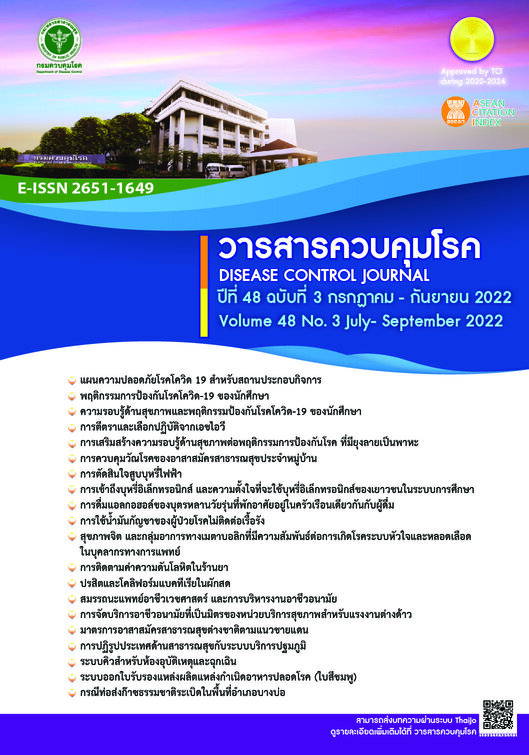พฤติกรรมและปัจจัยที่มีความสัมพันธ์กับการดื่มแอลกอฮอล์ของบุตรหลานวัยรุ่นที่พักอาศัยอยู่ในครัวเรือนเดียวกันกับผู้ดื่ม : กรณีศึกษาจังหวัดนครราชสีมา
DOI:
https://doi.org/10.14456/dcj.2022.48คำสำคัญ:
พฤติกรรมการดื่มแอลกอฮอล์, วัยรุ่น, การพักอาศัยอยู่ในครัวเรือนเดียวกันกับผู้ดื่มบทคัดย่อ
ครอบครัวเป็นสถาบันพื้นฐานอันดับแรกในการเป็นเบ้าหลอมให้มนุษย์เป็นสมาชิกที่ดีของสังคมโดยผ่านการขัดเกลาทางสังคม ซึ่งกระบวนการดังกล่าวมีส่วนสำคัญต่อความรู้ ทัศนคติ และการปฏิบัติตนของสมาชิกในครอบครัว โดยเฉพาะบุตรหลานวัยรุ่น การศึกษาครั้งนี้มีวัตถุประสงค์เพื่อประเมินพฤติกรรมการดื่มแอลกอฮอล์และปัจจัยที่เกี่ยวข้องของบุตรหลานที่พักอาศัยอยู่ในครัวเรือนเดียวกันกับพ่อแม่ ผู้ปกครอง ที่ดื่มแอลกอฮอล์ เก็บข้อมูลโดยใช้แบบสอบถามกับวัยรุ่นอายุ 13-18 ปี จำนวน 379 คน ที่อยู่อาศัยในอำเภอเมืองนครราชสีมา ผลการศึกษาพบว่ากลุ่มตัวอย่างเป็นเพศชาย ร้อยละ 50.9 มีอายุเฉลี่ย 14.71 ปี มีจำนวนสมาชิกในครัวเรือนเฉลี่ย 4.90 คน มีจำนวนผู้ดื่มเฉลี่ย 1.97 คน โดยมีบทบาทเป็นพ่อ ร้อยละ 38.5 และแม่ ร้อยละ 30.8 มีความรู้เกี่ยวกับโทษและผลกระทบจากการดื่มแอลกอฮอล์อยู่ในระดับไม่เหมาะสม ร้อยละ 71.24 มีทัศนคติในเชิงลบต่อการดื่มแอลกอฮอล์ ร้อยละ 68.6 และเคยมีประสบการณ์ดื่มแอลกอฮอล์ ร้อยละ 43.4 โดยปัจจุบันยังดื่มอยู่ ร้อยละ 17.8 ผู้ที่ยังดื่มอยู่ ร้อยละ 53.0 ตั้งใจว่าจะดื่มอยู่แล้วตั้งแต่ดื่มครั้งแรก โดยมีอายุเฉลี่ยที่เริ่มดื่ม 13.40 ปี เนื่องด้วยอยากรู้ อยากลอง ร้อยละ 86.4 ในรอบ 12 เดือนที่ผ่านมา กลุ่มตัวอย่างดื่มเบียร์บ่อยที่สุด ร้อยละ 70.2 โดยดื่มในช่วงเทศกาลและฉลองต่าง ๆ เมื่อมีความสุข ร้อยละ 71.9 กลุ่มตัวอย่างได้เครื่องดื่มแอลกอฮอล์มาด้วยวิธีการรวมเงินกับเพื่อนซื้อ ร้อยละ 45.5 รองลงมา คือ ดื่มฟรี โดยดื่มร่วมกับพ่อแม่ ผู้ปกครอง ร้อยละ 31.8 เมื่อประเมินความสัมพันธ์โดยใช้สถิติ Multiple logistic regression พบว่าอายุและทัศนคติต่อการดื่มแอลกอฮอล์มีความสัมพันธ์กับการดื่มแอลกอฮอล์ของบุตรหลานอย่างมีนัยสำคัญทางสถิติ (AOR=2.88, 95% CI=1.26-6.58 และ AOR=11.51, 95% CI=5.07-26.16 ตามลำดับ) ดังนั้น สถาบัน การศึกษา หน่วยงานที่เกี่ยวข้องกับเด็กและเยาวชน ควรจัดกิจกรรมสุขศึกษาเพื่อพัฒนาพฤติกรรมสุขภาพในระดับบุคคลและครอบครัว โดยสร้างการตระหนักรู้ในคุณค่าของตนเอง สร้างทัศนคติที่ถูกต้องต่อการดื่มแอลกอฮอล์ และสร้างความมั่นใจว่าตนเองจะปฏิเสธ หลีกเลี่ยง ปลีกตัวออกห่างจากผู้ดื่มได้ ทั้งนี้ ควรมีการติดตามประเมินผลอย่างต่อเนื่อง โดยเฉพาะในกลุ่มบุตรหลานอายุ 15-18 ปี ที่พักอาศัยอยู่ในครัวเรือนเดียวกันกับพ่อแม่ ผู้ปกครองที่ดื่มแอลกอฮอล์ นอกจากนี้ ควรรณรงค์ให้พ่อแม่ ผู้ปกครองตระหนักถึงผลดีของการไม่ดื่มแอลกอฮอล์ต่อหน้าบุตรหลาน ไม่ไหว้วานให้บุตรหลานไปซื้อเครื่องดื่มแอลกอฮอล์ และไม่ชักชวนให้บุตรหลานดื่มแอลกอฮอล์ โดยเฉพาะในช่วงเทศกาลแห่งความสุข
Downloads
เอกสารอ้างอิง
Areekun W. Psychological social development as adolescence [Internet]. 2012 [cited 2020 Jun 14]. Available from: https://53010518046.blogspot.com/2012/08/blog-post_5862.html. (in Thai)
Kuendig H, Kuntsche E. Family bonding and adolescent alcohol use: moderating effect of living with excessive drinking parents. Alcohol & Alcoholism. 2006;41(4):464-71.
Hfocus. The study found that children aged 4-6 years old were able to distinguish between intoxicated beverages because parents are eager drinkers who dreaded imitation [Internet]. 2018 [cited 2021 Apr 14]. Available from: https://www.hfocus.org/content/2018/05/15930. (in Thai)
Ausanangkornchai S, Saingam D, editors. Report on the situation of alcohol consumption in Thai society 2017. Songkla: Center for Alcohol Studies, Department of Epidemiology, Faculty of Medicine, Prince of Songkla University; 2019. (in Thai)
Tanaree A, Vichitkunakorn P. Alcohol drinking and Provincial Alcohol Problem Index (PAPI) in Thailand: The 2017 Survey. Journal of Heath Systems Research. 2019;13(4):353-67. (in Thai)
National Statistical Office (TH). The 2010 Population and Housing Census [Internet]. 2011 [cited 2021 Apr 1]. Available from: http://www.nso.go.th. (in Thai)
The Board of Directors of Drug Addiction Academic Network. Status of Alcohol Consumption in 2007. Songkla: Center for Alcohol Studies, Department of Epidemiology, Faculty of Medicine, Prince of Songkla University; 2007. (in Thai)
Ausanangkornchai S, editors. Provincial alcohol report 2017. Songkla: Center for Alcohol Studies, Department of Epidemiology, Faculty of Medicine, Prince of Songkla University; 2017. (in Thai)
Ausanangkornchai S, Chittrakan S, editors. Facts and figures: Alcohol in Thailand 2016-2018. Songkla: Center for Alcohol Studies, Department of Epidemiology, Faculty of Medicine, Prince of Songkla University; 2019. (in Thai)
Tritipsombut J. Problems for their adolescents found in households with drinking parents. Disease Control Journal. 2022;48(1):143-59. (in Thai)
Bandura A. Social learning theory. New Jersey: Prentice-Hall; 1977.
Kensee K, Sontirat S. Behavioral imitation, family relationship, life skill and risk sexual behavior of primary grade 6 student at Nong Chok District in Bangkok Metropolitan. Journal of Social Sciences and Humanities. 2020;46(1):113-45. (in Thai)
Tritipsombut J. Assessment of the impact of working-age parents’ alcohol consumption on younger relatives in Nakhon Ratchasima Province [Internet]. 2021 [cited 2021 May 31]. Available from: http://cas.or.th/cas/?p=7983. (in Thai)
Ministry of Interior (TH), Department of Provincial Administration. Population statistics for the year 2018, Nakhon Ratchasima Province [Internet]. 2019 [cited 2019 May 20]. Available from: https://stat.bora.dopa.go.th/new_stat/webPage/statByAge.php. (in Thai)
Jirawatkun A. Statistics for Health Sciences Research. 4th ed. Khon Kaen: Department of Epidemiology and Biostatistics, Faculty of Public Health, Khon Kaen University; 2015. (in Thai)
Best JW. Research in education. New Jersey: Prentice-Hall; 1977.
Bloom BS. Human characteristics and school learning. New York: McGraw Hill Book; 1976.
Waleewong O, Chaisong S, Thamarangsi T. Influence of parental norms and behaviours on youth drinking in Thailand. Songkla: Center for Alcohol Studies, Department of Epidemiology, Faculty of Medicine, Prince of Songkla University; 2010. (in Thai)
Onmoy P, Junrith K. Factors associated with alcohol access and drinking behavior of adolescents in Uttaradit Province. Journal of Health Science. 2020;29(4):590-600. (in Thai)
Hosiri T, Sittisun C, Limsricharoen K. Drinking behavior and its prevalence in grade 10th students. Journal of the Psychiatric Association of Thailand. 2016;61(1):3-14. (in Thai)
In Flight Wellness Weekly. The effects of mixing alcohol and tobacco. Tobacco Free Living. 2020;3(4):1-2.
Hart CL, Davey Smith G, Gruer L, Watt GC. The combined effect of smoking tobacco and drinking alcohol on cause-specific mortality: a 30 years cohort study. BioMed Central Public Health. 2010;10:789.
Ministry of Public Health (TH), Strategy and Planning Division. Public Health Statistics A.D. 2019 [Internet]. 2020 [cited 2021 Sep 3]. Available from: https://bps.moph.go.th/new_bps/sites/default/files/statistic62.pdf. (in Thai)
Boontae S. Characteristics and relevant factors of alcohol consumption as “regular drinking” of youth in the rural community: The case study in Longtong Community, Ban-Pho municipal district, Muang district, Nakhon Ratchasima province [thesis]. Pathum Thani: Puey Ungphakorn School of Development Studies Thammasat University; 2015. 233 p. (in Thai)
Thai Health Promotion Foundation. Trust your friends or believe yourself. Community Health Newsletter, Happy Edition, July. Thai Health Promotion Foundation. 2011;7(117):6. (in Thai)
Thai Health Promotion Foundation. The harmful effects of drinking and driving [Internet]. 2020 [cited 2021 Sep 10]. Available from: https://www.thaihealth.or.th/Content/53029-ส่องผลร้าย%20ที่ได้จากการดื่มแล้วขับ%20.html. (in Thai)
Chaikan A, Chaikan A. Alcohol drinking behaviors among undergraduate students of Phranakhon Si Ayutthaya Rajabhat University, Phranakhon Si Ayutthaya. Valaya Alongkorn Review (Humanities and Social Science). 2017;7(1):103-13. (in Thai)
Kawhai R. A study of positive attitude donation behaviors and media campaign approach affected motivating donation through underprivileged children of private company employees [thesis]. Pathum Thani: Bangkok university; 2017. 102 p. (in Thai)
Wilkinson GN, Rogers CE. Symbolic description of factorial models for analysis of variance. Journal of the Royal Statistical Society. Series C. 1973;22(3):392-9.
ดาวน์โหลด
เผยแพร่แล้ว
รูปแบบการอ้างอิง
ฉบับ
ประเภทบทความ
สัญญาอนุญาต
ลิขสิทธิ์ (c) 2022 วารสารควบคุมโรค

อนุญาตภายใต้เงื่อนไข Creative Commons Attribution-NonCommercial-NoDerivatives 4.0 International License.
บทความที่ลงพิมพ์ในวารสารควบคุมโรค ถือว่าเป็นผลงานทางวิชาการหรือการวิจัย และวิเคราะห์ตลอดจนเป็นความเห็นส่วนตัวของผู้เขียน ไม่ใช่ความเห็นของกรมควบคุมโรค ประเทศไทย หรือกองบรรณาธิการแต่ประการใด ผู้เขียนจำต้องรับผิดชอบต่อบทความของตน






